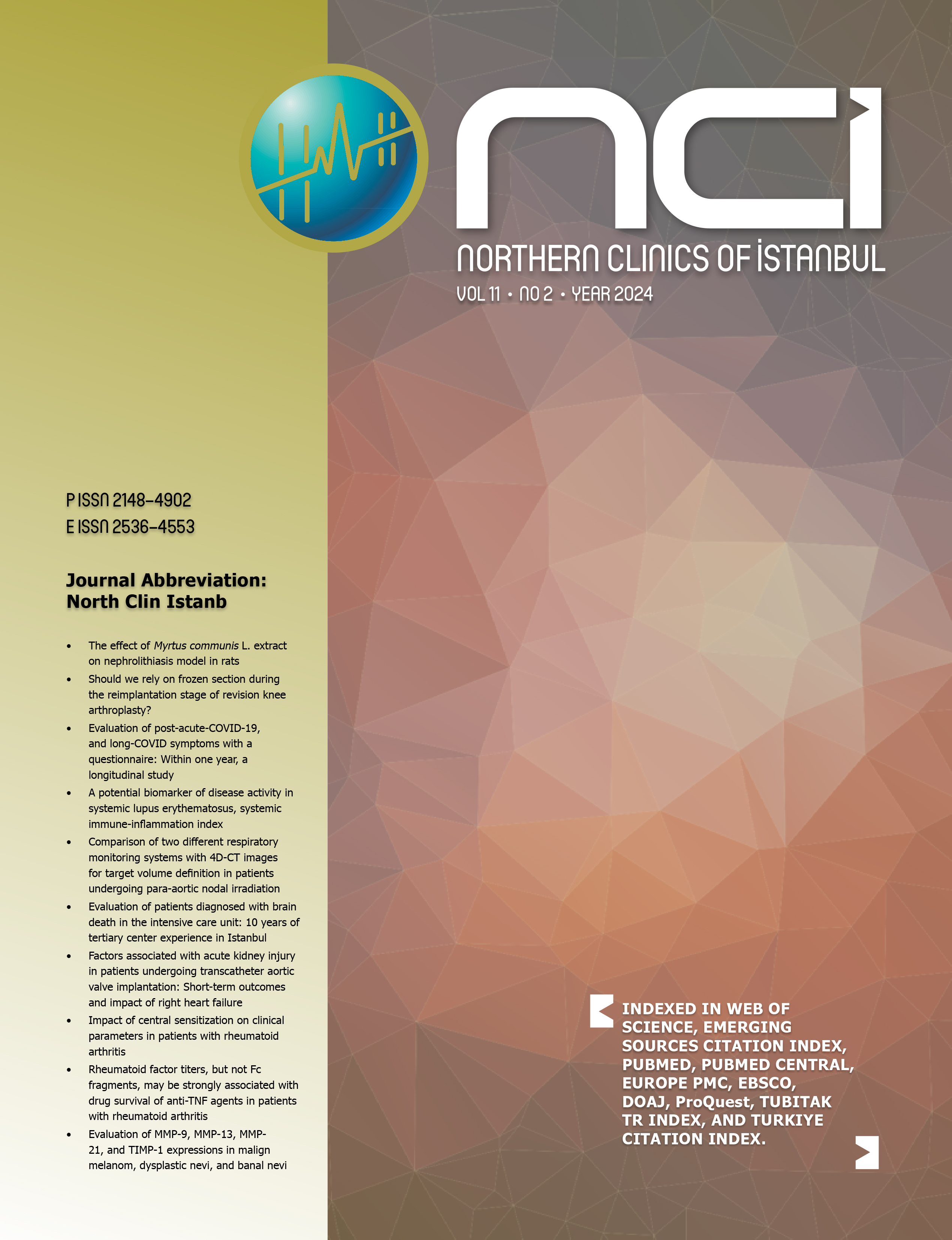Investigation of the presence of Epstein-Barr virus in patients who had Oral Lichen Planus and Oral Lichenoid Contact Lesions with Real-time PCR method in serum, tissue, and saliva samples
Alaeddin Oral1, Mustafa Onel2, Mehmet Demirci3, Cem Baysal4, Arat Hulikyan2, Hayriye Kirkoyun Uysal2, Ali Agacfidan2, Sertan Ergun11Department of Oral, Dental and Maxillofacial Surgery, Istanbul University Faculty of Dentistry, Istanbul, Turkiye2Department of Medical Microbiology, Istanbul University Istanbul Faculty of Medicine, Istanbul, Turkiye
3Department of Medical Microbiology, Kirklareli University Faculty of Medicine, Kirklareli, Turkiye
4Oral Dental and Maxillofacial Radiology, Istanbul Kent University Faculty of Dentistry, Istanbul, Turkiye
OBJECTIVE: Oral Lichen Planus (OLP) is an immune system disease and its cause has not been fully determined yet. Oral Lichenoid Contact Lesions (OLCL) is an allergic condition known to develop because of dental materials. It is considered that some infectious agents (e.g., Epstein-Barr virus (EBV)) play roles in the etiology of OLP and OLCL. The purpose of the present study was to investigate the presence of EBV in different clinical samples of patients who had OLP and OLCL, to show its relationship with OLCL, and to determine its role in etiopathogenesis in these patients.
METHODS: Twenty (20) OLCL, twenty-three (23) OLP, and twenty (20) healthy volunteers who applied to Istanbul University Faculty of Dentistry, Oral and Maxillofacial Surgery were included in the study, regardless of gender. Biopsy samples were taken from patients who had a 5mm punch, including the mucosa containing the lesion along with saliva and blood samples, and all clinical samples were sent to the Department of Medical Microbiology Laboratory under appropriate storage conditions. After the isolation of the DNA from clinical samples, EBV DNA was analyzed on the Light Cycler 480 II device by using Real-time PCR (RT-PCR) tests. The evaluation of the statistical data of the results was made by using the SPSS program.
RESULTS: When the data were evaluated, EBV DNA positivity was detected in 13.04% of the patients who had OLP, 10% of the patients who had OLCL, and 5% of the individuals in the Control Group. In saliva samples, EBV DNA was found positive in 21.74% of individuals with OLP, 15% of individuals with OLCL, and 10% of individuals in the Control Group. In the biopsy samples, EBV DNA was detected positive in 21.74% of the OLP patients, 15% of the OLCL patients, and 10% of the Control Group individuals.
CONCLUSION: Based on the findings of the present study, no significant differences were observed in the presence of EBV DNA or the quantitative viral load between patients with OLP, OLCL, and the Control Group. However, the quantitative EBV DNA results varied depending on the type of clinical sample selected. We believe that comprehensive studies that will include a larger number of samples must be conducted to determine the role of EBV in OLP and OLCL.
Keywords: EBV; Oral Lichen Planus; Oral Lichenoid Contact Lesions; Real-time PCR
Oral Liken Planus ve Oral Likenoid Kontakt Lezyonu bulunan hastalarda Epstein-Barr virüsünün varliğinin serum, doku ve tükürük örneklerinde Real-time PCR yöntemi ile araştırılması
Alaeddin Oral1, Mustafa Onel2, Mehmet Demirci3, Cem Baysal4, Arat Hulikyan2, Hayriye Kirkoyun Uysal2, Ali Agacfidan2, Sertan Ergun11İstanbul Üniversitesi Diş Hekimliği Fakültesi, Ağız, Diş ve Çene Cerrahisi Anabilim Dalı, İstanbul2İstanbul Üniversitesi İstanbul Tıp Fakültesi, Tıbbi Mikrobiyoloji Anabilim Dalı, İstanbul
3Kırklareli Üniversitesi Tıp Fakültesi, Tıbbi Mikrobiyoloji Anabilim Dalı, Kırklareli
4İstanbul Kent Üniversitesi Diş Hekimliği Fakültesi, Ağız Diş ve Çene Radyolojisi, İstanbul
Amaç: Oral Liken Planus (OLP), henüz nedeni tam olarak belirlenememiş bir immün sistem hastalığıdır. Oral Likenoid Kontakt Lezyonlar (OLKL) ise dental materyaller nedeniyle geliştiği bilinen alerjik bir tablodur. OLP ve OLKL etyolojisinde Epstein-Barr Virus (EBV) gibi bazı enfeksiyöz ajanların rol oynadığı düşünülmektedir. Çalışmamızda, OLP ve OLKLli hastalara ait farklı klinik örneklerdeki EBV varlığının araştırılması, özellikle OLKL ile ilişkisinin gösterilmesi ve bu hastalarda etiyopatogenezdeki rolünün belirlenmesi amaçlanmıştır.
Gereç ve Yöntem: İstanbul Üniversitesi Diş Hekimliği Fakültesi, Ağız Diş Çene Cerrahisine başvuran, yirmi (20) OLKL, yirmi üç (23) OLP ve yirmi (20) sağlıklı gönüllü birey cinsiyet ayrımı gözetmeksizin çalışma kapsamına alınmıştır. Hasta bireylerden lezyonu içeren mukozayı da içerecek şekilde 5mmlik punch ile biyopsi örnekleri alınmıştır. Aynı bireylerden ayrıca tükürük ve kan örnekleri alınmış, tüm klinik örnekler Tıbbi Mikrobiyoloji Anabilim Dalı laboratuvarına uygun saklama koşullarında gönderilmiştir. Klinik örneklerden yapılan DNA izolasyonu sonrası EBV DNA, Real-Time PCR (RT-PCR) testleri kullanılarak LightCycler 480 II cihazında analiz edilmiştir. Sonuçlara ait istatistiksel verilerin değerlendirmesi SPSS programı kullanılarak yapılmıştır.
Bulgular: Elde edilen veriler değerlendirildiğinde; hastalara ait kan örneklerinde OLPlilerin %13.04ünde, OLKLlilerin %10unda, kontrol grubunda yer alan bireylerin %5inde EBV DNA pozitifliği saptanmıştır. Tükürük örneklerinde ise OLPlilerin %21,74ünde, OLKLlilerin %15inde, kontrol grubundaki bireylerin %10unda EBV DNA pozitif olarak bulunmuştur. Biyopsi örneklerinde ise OLPlilerin %21,74ünde, OLKLlilerin %15inde, kontrol grubunda yer alan bireylerin ise %10unda EBV DNA pozitif olarak saptanmıştır.
Sonuç: Çalışmamızın sonucunda, OLP ve OLKLli hastalarda EBV DNAnın varlığı ve kantitatif yükü açısından kontrol grubuna göre anlamlı bir fark saptanmazken, kantitatif EBV DNA sonucunun seçilen klinik örneğe göre değişkenlik gösterdiği tespit edilmiştir. EBVnin, OLP ve OLKL hastalıklarındaki rolünün belirlenebilmesi için daha fazla örnek sayısı içeren kapsamlı çalışmaların yapılması gerektiği düşüncesindeyiz. (NCI-2024-10-4)
Anahtar Kelimeler: EBV; Oral Liken Planus; Oral Likenoid Kontakt Lezyonlar; Real-time PCR.
Manuscript Language: English





















